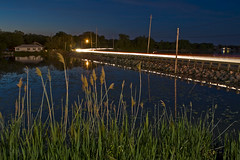
As many of you know, my job involves looking for rare
plants and high quality natural ares in the
Lake Erie watershed portion of Ohio. Searching for rare plants is a combination of knowledge, intuition, sticktoitiveness, extreme attention to detail, and sometimes downright luck. Last week, I searched for the tiny one flowered wintergreen at Oak Openings Metropark for about 3 hours, only to come up empty. It was the only sight know for that little plant in Ohio, and if I can't find it in the next week or two, it will probably be considered an extirpated species instead of endangered, because it won't have been seen for over twenty years.
Today was a different story. I went to relocate
Iris brevicaulis at Dupont Marsh State Nature Preserve, adjacent to the Huron River in Erie County. Coupled with the knowledge of where the plant had been found, and the knowledge provided to me by my guide today, Brad Phillips of Erie Metroparks, were were able to locate this beautiful iris within about 5 minutes of stepping off the trail. A good day, indeed. This species was last documented from
Dupont Marsh in 1991. It differs from our other blue irises, mostly distinctly, by its short, zig-zag stem, spreading perianth (the flower), and its 6 angled capsule (if fruiting).


Here's the more common iris of the Lake Erie marshes,
Iris versicolor. I snapped this shot at the Navarre Unit of the
Ottawa National Wildlife Refuge while co-worker Rick Gardner and I were surveying the vegetation of the diked marshes in the area, so very close to the
Davis-Besse nuclear power station.

Notice how much longer the flowering stems are in the directly above, and then compare that with the low flower image in the next image up- the
Iris versicolor flowers are the same height as the leaves, whereas the
Iris brevicaulis flowers are hidden amongst the lower reaches of the blades.
It's always nice to find what you're looking for, and today, that is exactly what happened.
Tom


























 and finally, a Pucoon, a Lithospermum species.
and finally, a Pucoon, a Lithospermum species. Isn't this butterfly weed, covered with eleven (can you count more?) great spangled fritillaries, spectacular? We had a great time botanzing and naturalizing on last Friday's trip to Adams County, which one of Ohio's southernmost counties on the Ohio River. No names today, please just enjoy the photos of these plants and animals. Thanks to the Ohio Heritage Naturalists for a great trip.
Isn't this butterfly weed, covered with eleven (can you count more?) great spangled fritillaries, spectacular? We had a great time botanzing and naturalizing on last Friday's trip to Adams County, which one of Ohio's southernmost counties on the Ohio River. No names today, please just enjoy the photos of these plants and animals. Thanks to the Ohio Heritage Naturalists for a great trip.







 Tom
Tom

 Singer Lake Bog, 2006. This vegetation filled water basin can be treacherous. The sort of olive green, round shaped leaves with an upward pointing tip are those of spatterdock
Singer Lake Bog, 2006. This vegetation filled water basin can be treacherous. The sort of olive green, round shaped leaves with an upward pointing tip are those of spatterdock















